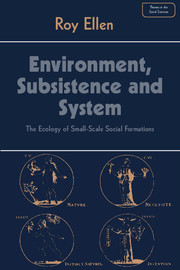Book contents
- Frontmatter
- Contents
- Preface
- Acknowledgements
- 1 ENVIRONMENTAL DETERMINISM AND CAUSAL CORRELATION
- 2 POSSIBILISM AND LIMITING FACTORS
- 3 CULTURAL ECOLOGY AND THE EXPLANATORY IMPERATIVE
- 4 HUMAN ECOLOGY AND THE BIOLOGICAL MODEL
- 5 THE FLOW OF ENERGY AND MATERIALS
- 6 ECOSYSTEMS AND SUBSISTENCE PATTERNS I
- 7 ECOSYSTEMS AND SUBSISTENCE PATTERNS II
- 8 SYSTEMS AND THEIR REGULATION
- 9 INFORMATION AND THE MANIPULATION OF THE ENVIRONMENT
- 10 ADAPTATION: A SUMMARY AND RECONSIDERATION
- 11 THE REPRODUCTION AND EVOLUTION OF SOCIAL AND ECOLOGICAL SYSTEMS
- 12 ECOLOGY IN ANTHROPOLOGICAL METHOD AND THEORY
- Notes
- Bibliography
- Name Index
- Subject Index
9 - INFORMATION AND THE MANIPULATION OF THE ENVIRONMENT
Published online by Cambridge University Press: 05 June 2012
- Frontmatter
- Contents
- Preface
- Acknowledgements
- 1 ENVIRONMENTAL DETERMINISM AND CAUSAL CORRELATION
- 2 POSSIBILISM AND LIMITING FACTORS
- 3 CULTURAL ECOLOGY AND THE EXPLANATORY IMPERATIVE
- 4 HUMAN ECOLOGY AND THE BIOLOGICAL MODEL
- 5 THE FLOW OF ENERGY AND MATERIALS
- 6 ECOSYSTEMS AND SUBSISTENCE PATTERNS I
- 7 ECOSYSTEMS AND SUBSISTENCE PATTERNS II
- 8 SYSTEMS AND THEIR REGULATION
- 9 INFORMATION AND THE MANIPULATION OF THE ENVIRONMENT
- 10 ADAPTATION: A SUMMARY AND RECONSIDERATION
- 11 THE REPRODUCTION AND EVOLUTION OF SOCIAL AND ECOLOGICAL SYSTEMS
- 12 ECOLOGY IN ANTHROPOLOGICAL METHOD AND THEORY
- Notes
- Bibliography
- Name Index
- Subject Index
Summary
Man's contact with nature has never been direct; it has always been mediated through knowledge structures via his senses and his intellect. We have no other means of knowing the world around us.
Moscovici 1976:145INTRODUCTION
Most of the older formulations of the ecological problematic ignore the theoretical significance of human interpretation of the environment, treat it as irrelevant or assign it to some unexamined (perhaps unexaminable) ‘black box’ which mysteriously mediates between humans and their environment. It was generally assumed that social organization and culture responded mechanistically to environmental stimuli. The impact of the capacity and limitations of Homo sapiens in interpreting the environment, handling information in complex ways and using information to direct behaviour went unappreciated; as did the fact that societies, groups and individuals see their environment in noticeably different ways, with varying implications for ecological interactions. This was so even for possibilism, despite its stress on the explanatory priority of social behaviour and collective representations.
Systems approaches provide a convenient theoretical means of understanding the function and effects of environmental perception. Information, energy and materials are distinct interacting and integral components of a system, although, in the last instance, information is dependent on some physical base. In social systems, flows of matter and energy link and articulate physical elements, and information does likewise for their images (Langton 1973:132). The sensed environment is no more than the sum total of images of material things, largely organized through categories, and is the source of all information.
- Type
- Chapter
- Information
- Environment, Subsistence and SystemThe Ecology of Small-Scale Social Formations, pp. 204 - 235Publisher: Cambridge University PressPrint publication year: 1982



